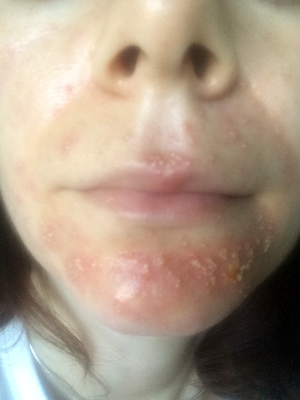CASE REPORT
Histamine intolerance caused by Diamine Oxidase (DAO) deficiency – case report
1
Student Research Group at the Department and Clinic of Gastroenterology with Endoscopy Laboratory, Medical University of Lublin, Poland
2
Department and Clinic of Gastroenterology with Endoscopy Laboratory, Medical University of Lublin, Poland
Corresponding author
Aleksandra Iwona Zimna
Student Research Group at the Department and Clinic of Gastroenterology with Endoscopy Laboratory, Medical University of Lublin, Jaczewskiego 8, 20-400, Lublin, Poland
Student Research Group at the Department and Clinic of Gastroenterology with Endoscopy Laboratory, Medical University of Lublin, Jaczewskiego 8, 20-400, Lublin, Poland
J Pre Clin Clin Res. 2022;16(3):81-84
KEYWORDS
TOPICS
ABSTRACT
Histamine is a biogenic amine, which occurs naturally in the human body. Histamine can be metabolised with Diamine
Oxidase (DAO) Enzyme. It is estimated that in 1% of people, as a result of an imbalance between the supply and degradation
of histamine, a condition called histamine intolerance (HIT) develops. The case report describes a 40-year-old women who
visited the Emergency Room several times due to quickly increasing face oedema, rush, chest pain and dyspnoea after
eating meals containing histamine. For many years, the patient has struggled with non-specific symptoms. The woman
decided to have a test performed to determine the enzymatic activity of DAO in the blood serum. The result was 5 U/ml,
which indicates a significant shortage of DAO. Taking into consideration the symptoms the patient presented, extensive
differential diagnosis, which excluded the presence of other diseases and serum DAO activity test, it was possible to diagnose
histamine intolerance caused by DAO deficiency
Zimna AI, Wróblewski H, Dubaj M, Dembowska A, Gawryś A, Skrzydło-Radomańska B. Histamine intolerance caused by Diamine Oxidase
(DAO) deficiency – case report. J Pre-Clin Clin Res. 2022; 16(3): 81–84. doi: 10.26444/jpccr/153097
REFERENCES (12)
1.
Kovacova-Hanuskova E, Buday T, Gavliakova S, Plevkova J. Histamine, histamine intoxicationand intolerance. Allergol Immunopathol (Madr). 2015;43:498–506. https://doi.org/10.1016/J.ALLE....
2.
Maintz L, Novak N. Histamine and histamine intolerance. Am J Clin Nutr. 2007;85:1185–96. https://doi.org/10.1093/AJCN/8....
3.
Manzotti G, Breda D, Di Gioacchino M, Burastero SE. Serum diamine oxidase activity in patients with histamine intolerance. Int J Immunopathol Pharmacol. 2016;29:105–11. https://doi.org/10.1177/039463....
4.
Hrubisko M, Danis R, Huorka M, Wawruch M. Histamine Intolerance-The More We Know the Less We Know. A Review. Nutrients. 2021;13(7):2228. https://doi.org/10.3390/NU1307....
5.
Comas-Basté O, Sánchez-Pérez S, Veciana-Nogués MT, Latorre-Moratalla M, Vidal-Carou MDC. Histamine Intolerance: The Current State of the Art. Biomolecules. 2020;10:1–26. https://doi.org/10.3390/BIOM10....
6.
Eade G. Histamine Intolerance: why freshness matters. J Evol Heal A Jt Publ Ancestral Heal Soc Soc Evol Med Heal. 2018;2. https://doi.org/10.15310/2334-....
7.
Arbeitsanleitung/Manual IDK® DAO ELISA Zur in-vitro-Bestimmung von Diaminooxidase (DAO) in Serum und Trockenblutproben For the in vitro determination of DAO inserum and dried blood spots https://www.immundiagnostik.co... (access: 2022.07.18).
8.
Beltrán-Ortiz C, Peralta T, Ramos V, Durán M, Behrens C, Maureira D, et al. Standardization of a colorimetric technique for determination of enzymatic activity of diamine oxidase (DAO) and its application in patients with clinical diagnosis of histamine intolerance. World Allergy Organ J. 2020;13:100457. https://doi.org/10.1016/j.waoj....
9.
Schnedl WJ, Enko D. Histamine Intolerance Originates in the Gut. Nutrients. 2021;13:1262. https://doi.org/10.3390/NU1304....
10.
Schnedl WJ, Schenk M, Lackner S, Enko D, Mangge H, Forster F. Diamine oxidase supplementation improves symptoms in patients with histamine intolerance. Food Sci Biotechnol. 2019;28:1779–1784. https://doi.org/10.1007/S10068....
11.
Reese I, Ballmer-Weber B, Beyer K, Fuchs T, Kleine-Tebbe J, Klimek L, et al. German guideline for the management of adverse reactions to ingested histamine: Guideline of the German Society for Allergology and Clinical Immunology (DGAKI), the German Society for Pediatric Allergology and Environmental Medicine (GPA), the German Association of Allergologists (AeDA), and the Swiss Society for Allergology and Immunology (SGAI). Allergo J Int. 2017;26:51–61. https://doi.org/10.1007/S40629....
12.
Zhao Y, Zhang X, Jin H, Chen L, Ji J, Zhang Z. Histamine Intolerance-A Kind of Pseudoallergic Reaction. Biomolecules. 2022; 12:40–48. https://doi.org/10.3390/BIOM12....
We process personal data collected when visiting the website. The function of obtaining information about users and their behavior is carried out by voluntarily entered information in forms and saving cookies in end devices. Data, including cookies, are used to provide services, improve the user experience and to analyze the traffic in accordance with the Privacy policy. Data are also collected and processed by Google Analytics tool (more).
You can change cookies settings in your browser. Restricted use of cookies in the browser configuration may affect some functionalities of the website.
You can change cookies settings in your browser. Restricted use of cookies in the browser configuration may affect some functionalities of the website.


